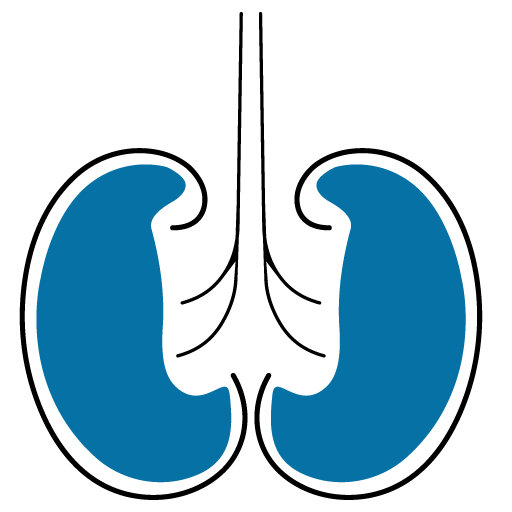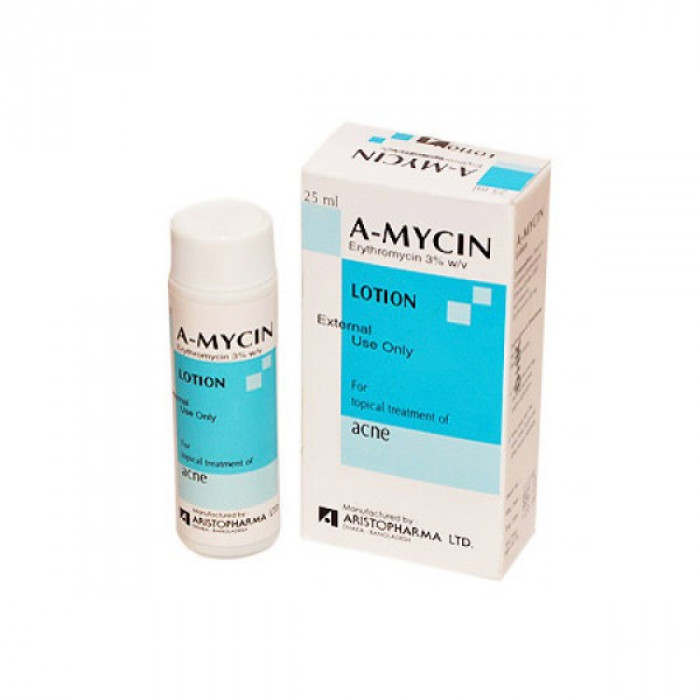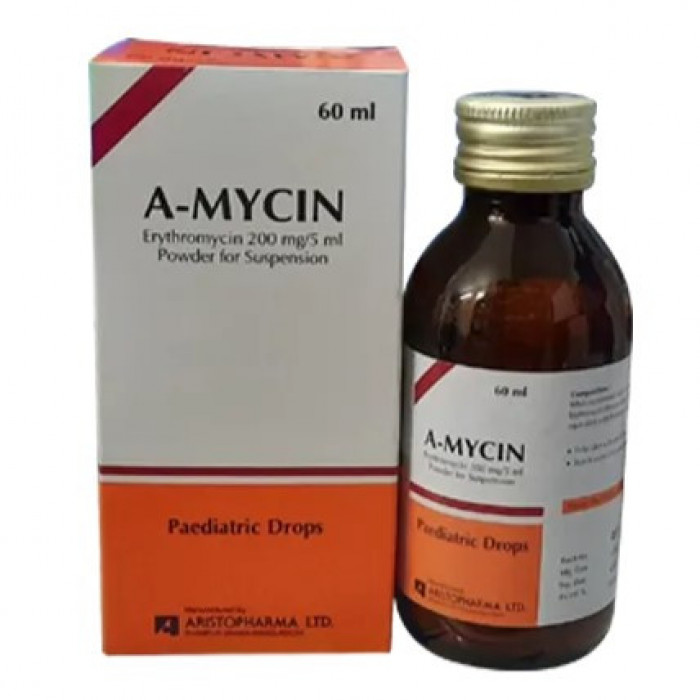
✔ 100% Authentic Product
👁️ Currently Viewing 742
A-Mycin 250mg Tablet
A-Mycin 250mg Tablet prevents and treats bacterial infections such as:
- Throat and sinus infections
- Chest infections (such as bronchitis and pneumonia)
- Ear infections
- Mouth and dental infections
- Eye infections
- Skin and tissue infections (such as acne)
- Stomach and intestinal infections
- Prevention of infection following burns, operations, or dental procedures
- Other infections (such as sexually transmitted diseases, bone infections or scarlet fever)

✅ Description:
Erythromycin is a highly effective antibiotic used to treat a wide range of clinical infections, including:
Upper Respiratory Tract Infections:
- Tonsillitis
- Peritonsillar abscess
- Pharyngitis
- Laryngitis
- Sinusitis
- Secondary infections in colds and influenza
Lower Respiratory Tract Infections:
- Tracheitis
- Acute and chronic bronchitis
Ear Infections:
- Otitis media
- Otitis externa
- Mastoiditis
Eye Infections:
- Blepharitis
- Established trachoma
Skin and Soft Tissue Infections:
- Boils and carbuncles
- Impetigo
- Abscesses
- Pustular acne
- Paronychia
- Cellulitis
- Erysipelas
Gastrointestinal Tract Infections:
- Cholecystitis
- Staphylococcal enterocolitis
Prophylaxis:
- Pre and post-operative
- Trauma
- Burns
- Rheumatic fever
Other Infections:
- Osteomyelitis
- Diphtheria
- Scarlet fever
- Whooping cough
Safety Advices

Alcohol
UNSAFE
Consumption of alcohol is not recommended during treatment with A-Mycin 250mg Tablet.

Pregnancy
CONSULT YOUR DOCTOR
A-Mycin 250mg Tablet should be used during pregnancy only if considered clearly necessary. Consult your doctor before taking A-Mycin 250mg Tablet.

Breastfeeding
CONSULT YOUR DOCTOR
A-Mycin 250mg Tablet should be used with caution in breastfeeding women. Consult your doctor before taking A-Mycin 250mg Tablet.

Driving
CAUTION
A-Mycin 250mg Tablet does not influence your ability to drive or operate any machines.

Kidney
CONSULT YOUR DOCTOR
A-Mycin 250mg Tablet should be used with caution in patients with liver problems. Consult your doctor before taking A-Mycin 250mg Tablet.

Liver
CONSULT YOUR DOCTOR
A-Mycin 250mg Tablet should be used with caution in patients with liver problems. Consult your doctor before taking A-Mycin 250mg Tablet.
✔️ Uses:
- Bacterial infections
✔️ How does A-Mycin 250mg Tablet work?
A-Mycin 250mg Tablet is an antibiotic. It works by preventing the synthesis of essential proteins required by bacteria to carry out vital functions. Thus, it stops the bacteria from growing and prevents the infection from spreading.
✔️ Side Effects of A-Mycin 250mg Tablet
Allergic reactions are rare and mild, although anaphylaxis has occurred. Occasionally, there is abdominal discomfort after oral administration, sometimes with nausea and vomiting. This discomfort usually subsides after a few days without the need to reduce the dosage.
✔️ Quick Suggestions:
- Your doctor has prescribed A Mycin to cure your infection and improve your symptoms.
- Do not skip any doses and finish the full course of treatment even if you feel better. Stopping it early may make the infection come back and harder to treat.
- Take it 1 hour before or two hours after food.
- Do not take antacids 2 hours before or after taking A Mycin.
- Diarrhea may occur as a side effect but should stop when your course is complete. Inform your doctor if it doesn't stop or if you find blood in your stools.
- Stop taking A Mycin and inform your doctor immediately if you develop an itchy rash, swelling of the face, throat, or tongue, or breathing difficulties while taking it.
✔️ Indication of A-Mycin 250mg Tablet
A-Mycin 250mg Tablet is an antibiotic used to treat various types of infections.
✔️ Pharmacology
Mechanism of Action:
Erythromycin exerts its antibacterial effect by inhibiting microsomal protein synthesis in susceptible organisms, primarily by inhibiting the translocation process during protein synthesis. It achieves this through specific binding to the 50S subunit or 70S ribosome in these organisms. Importantly, erythromycin does not bind to the stable 80S mammalian ribosome, which is found in human cells. This selective binding allows erythromycin to target bacterial and certain microbial infections while sparing mammalian cells.
Erythromycin exhibits activity against a broad spectrum of microorganisms, including many Gram-positive bacteria, some Gram-negative bacteria, as well as mycoplasmas and chlamydia.
Absorption:
Erythromycin base is susceptible to degradation by stomach acid, so it is typically administered in the form of more stable esters. The rate of absorption of both the base and esters is reduced when taken with food. In the intestine, the ester forms are hydrolyzed, releasing free erythromycin, which is then absorbed into the bloodstream.
Blood Concentration:
Following an oral dose of 500 mg of erythromycin base or stearate, peak serum concentrations of 0.9 to 1.4 mg/ml or 0.4 to 1.8 mg/ml, respectively, are typically reached within 1 to 4 hours. The serum half-life of erythromycin ranges from 1.2 to 4 hours in most individuals. However, in subjects with reduced urine output (oliguria), the half-life can extend to approximately 5 hours.
Distribution:
Erythromycin has a wide distribution throughout various body tissues and fluids. It shows some degree of retention in the liver and spleen. Protein binding of erythromycin base is approximately 73%. Notably, erythromycin can penetrate the cerebrospinal fluid in cases of meningeal inflammation, allowing it to potentially treat infections of the central nervous system. Additionally, erythromycin can cross the placenta, reaching the developing fetus, and is excreted in breast milk.
Excretion:
Approximately 5 to 15% of the administered dose of erythromycin is excreted in the urine. A significant portion of the unchanged active substance is eliminated through the bile.
✔️ Dosage & Administration of A-Mycin 250mg Tablet
Adults and Children over 8 years: 250-500 mg every six hours for mild to moderate infections. This dosage may be increased up to 4 gm. or more daily in severe cases.
Elderly: No special dosage recommendation. Erythromycin may be administered three times daily or twice daily, with one-third or half of the total daily requirement given every 8 hours or 12 hours, respectively.
Children aged 2 to 8 years: 250 mg every six hours or 30-50 mg/kg body weight per day, divided into four equal doses.
Infants and Children up to 2 years: 500 mg in divided doses or 30-50 mg/kg body weight in divided doses.
In case of overdosage, Erythromycin should be discontinued. Overdosage should be handled with prompt elimination of unabsorbed drug, and all other appropriate measures should be instituted. Erythromycin is not removed by peritoneal dialysis or hemodialysis.
✔️ Interaction
Recent data from studies of A-Mycin indicates that its use in patients who are concurrently receiving high doses of theophylline may lead to elevated serum theophylline levels, potentially resulting in theophylline toxicity. In such instances, it is advisable to reduce the theophylline dosage to mitigate this risk.
✔️ Contraindications
Known hypersensitivity to Erythromycin
✔️ Pregnancy & Lactation
Clinical and laboratory studies have shown no evidence in humans of teratogenicity or toxicity. However, caution should be exercised when prescribing this drug to pregnant patients and lactating mothers, as erythromycin crosses the placental barrier and is excreted in breast milk.
✔️ Precautions & Warnings
Erythromycin should be given with care in patients with impaired hepatic function, as erythromycin is excreted primarily in the bile.
✔️ Storage Conditions
Store below 25°C temperature, away from light and moisture. Keep out of the reach of children.
⚠️Disclaimer:
At ePharma, we’re committed to providing accurate and accessible health information. However, all content is intended for informational purposes only and should not replace medical advice from a qualified physician. Please consult your healthcare provider for personalized guidance. We aim to support, not substitute, the doctor-patient relationship.









